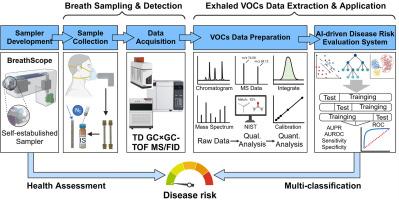集成的智能质谱分析平台可实现基于挥发物的呼吸活检
IF 6.2
引用次数: 0
摘要
呼出的挥发性有机化合物(VOCs)作为疾病诊断的非侵入性生物标志物具有很大的前景。然而,传统的呼气VOCs采样和分析方法在背景噪声、样品稳定性、灵敏度和分辨率方面存在明显的局限性。此外,不同疾病之间共有的挥发性有机化合物特征对单一疾病模型的准确诊断构成了挑战。这些限制阻碍了对痕量挥发性有机化合物全谱的准确分析,并限制了它们的大规模临床应用。为了解决这一技术差距,我们开发了一个综合的呼出VOCs分析平台,该平台集成了自主开发的BreathScope采样器和GC × GC- tof MS/FID检测系统,并辅以优化的采样策略和标准化的工作流程。与传统方法相比,BreathScope通过精确定位潮末呼吸,提高了捕获voc的多样性和浓度,有效减少了外源化合物的干扰。该分析系统成功鉴定出数百种痕量VOCs,具有较高的定量精度(R²>;0.97),精密度(RSD <;10%),检测和定量限在ng/L水平。此外,我们确定了最佳样本量,并展示了混杂因素对VOC概况的影响,强调了标准化采样协议的必要性。利用509名受试者呼出的VOCs数据,我们构建了多类别随机森林模型,用于结直肠癌、胃癌和脑癌的风险评估,AUROC值为0.98-0.99,灵敏度和特异性均超过0.95。总之,我们的平台集成了高保真呼气采集、痕量挥发性有机化合物量化和人工智能驱动的疾病预测,从而提高了呼吸活检在早期疾病筛查中的实用性和标准化,并为无创精准医疗提供了可复制的技术框架。本文章由计算机程序翻译,如有差异,请以英文原文为准。

Integrated smart mass spectrometry platform enables volatilomics based breath biopsy
Exhaled volatile organic compounds (VOCs) hold great promise as non-invasive biomarkers for disease diagnosis. However, conventional exhaled VOCs sampling and analytical methods suffer from significant limitations in background noise, sample stability, sensitivity, and resolution. Moreover, shared VOCs signatures across different diseases poses challenges to accurate diagnosis within single-disease models. These limitations hinder accurate profiling of the full spectrum of trace VOCs and constrain their large-scale clinical application. To address this technological gap, we developed a comprehensive exhaled VOCs analysis platform integrating a self-developed BreathScope sampler and a GC × GC-TOF MS/FID detection system, complemented by optimized sampling strategies and standardized workflows. Compared with conventional methods, BreathScope enhanced both the diversity and concentration of captured VOCs by precisely targeting end-tidal breath, effectively reducing interference from exogenous compounds. The analytical system successfully identified hundreds of trace VOCs, demonstrating high quantitative accuracy (R² > 0.97), precision (RSD < 10 %), with a detection and quantitation limit at the ng/L level. Additionally, we identified the optimal sample volume and demonstrated the impact of confounding factors on VOC profiles, highlighting the necessity for standardized sampling protocols. Utilizing exhaled VOCs data from 509 subjects, we constructed a multi-class random forest model for risk assessment of colorectal, gastric, and brain cancers, achieving AUROC values of 0.98–0.99, with sensitivity and specificity exceeding 0.95. Altogether, our platform integrates high-fidelity breath collection, trace VOCs quantification, and AI-driven disease prediction, thereby enhancing the utility and standardization of breath biopsy for early disease screening and offering a reproducible technological framework for non-invasive precision medicine.
求助全文
通过发布文献求助,成功后即可免费获取论文全文。
去求助

 求助内容:
求助内容: 应助结果提醒方式:
应助结果提醒方式:


